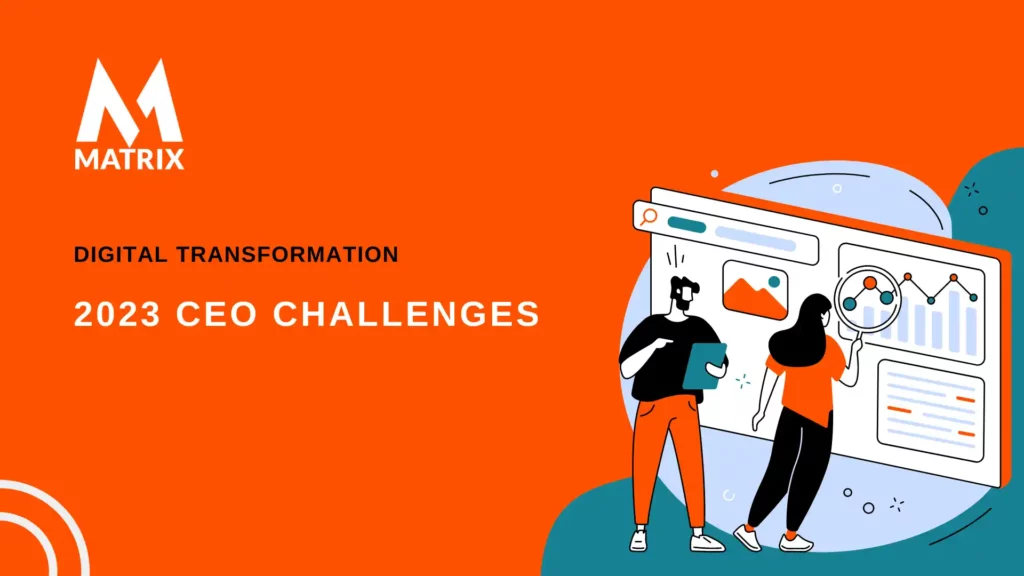In 2023 CEO Challenges Come from Internal and External Forces
2023 CEO challenges seem to be coming from all directions and fast.
The business world is constantly evolving, and today’s CEOs will face many challenges in 2023. From digital transformation to talent management and retention, embracing new technologies such as AI and machine learning, dealing with global economic pressures, and managing remote teams and customer experience, the list of potential issues is endless.
The 2023 New Year message from CEO is productivity, the customer, and ROI. CEOs are announcing scale up challenges for digital transformation. Talk about your challenges.
With so much uncertainty, it can be daunting for even the most experienced CEO to prepare for what lies ahead. This blog post explores some of these topics. It provides insight into how CEOs can best position themselves to meet the inevitable challenges they may face in 2023 – including a brand-new digital business model.
Are you a CEO looking for ways to prepare for the future?
This blog post provides insight into how CEOs can best position themselves to meet these inevitable challenges they may face in 2023 – including a brand-new digital business model.
With this knowledge, you can be better prepared for whatever comes your way.
Digital transformation is one of the major challenges that CEOs will face in 2023. In 2021 and 2022, digital transformation has become increasingly important for businesses as companies strive to keep up with the ever-changing and competitive global economy.
75% of organizations have committed to digital transformation initiatives, with over 65% had planned to implement them in 2023, according to a report released by Gartner.
Many companies are adopting technologies such as artificial intelligence (AI) and machine learning (ML). These technologies are helping organizations gain better insights into their customer base, increase efficiency and improve customer experience.
In addition, over 80% of companies have invested in cloud computing solutions in 2021 and 2022. Cloud computing offers businesses scalability, agility, and cost savings while allowing them to access data from any connected device or location. It also allows companies to analyze data faster than ever before and use it to improve customer service, which is critical for staying ahead of competitors.
Finally, more organizations are investing in automation technologies such as robotic process automation (RPA) and natural language processing (NLP). Robotic process automation automates mundane tasks like data entry or customer inquiries so that employees can focus on higher value-added activities. Natural language processing allows machines to understand human language better to automate tasks like customer service conversations or medical diagnoses without human involvement.
Overall, digital transformation has been a major trend throughout 2021 and 2022 due to its ability to help businesses stay competitive in the ever-changing global marketplace of today’s world. With this knowledge, CEOs can be better prepared for the inevitable challenges they may face in 2023 when managing digital transformation initiatives successfully.
Challenge with technology complexity

One of the major challenges that CEOs will face in 2023 is technology complexity. As more organizations adopt digital transformation initiatives, embracing emerging technologies such as AI and ML, and investing in automation, managing such complex systems can be difficult and resource-intensive.
For example, when companies use AI and ML for predictive analytics or automated troubleshooting processes, they must ensure their data is accurate and up-to-date. Any errors or discrepancies with the data can lead to inaccurate decision-making by the machines. This can cause financial losses or other business problems. Companies must manage their resources efficiently.
Moreover, when adopting cloud computing solutions, companies must also consider the security implications of this move. Cloud computing makes businesses more vulnerable to cyber threats since data is stored in one centralized location online. As a result, organizations must ensure proper cybersecurity measures are taken to protect their data from being compromised by malicious actors online.
Finally, when introducing automation technologies like RPA or NLP into their operations, companies need to consider how these technologies will interact with other existing systems within the organization. Without careful thought given to this process, there’s a risk of creating tech silos which could lead to data fragmentation or system incompatibility in the long run.
Overview of Digital Transformation and Emerging Technologies
- What is Digital Transformation, and How Can it Help Businesses
- Benefits of Digital Transformation for Companies
- Overview of Emerging Technologies, such as AI and ML
- Advantages of Automation Technologies like RPA and NLP
- Challenges with Technology Complexity
- Steps to Prepare CEOs for the Challenges in 2023
- Final Thoughts on Digital Transformation and Emerging Technologies
Ensuring Data Accuracy and Resource Management
Ensuring data accuracy and resource management are key challenges that CEOs will face in 2023 due to the rapid advancement of digital transformation initiatives and emerging technologies. Companies must manage their resources efficiently while ensuring their data’s accuracy to make informed decisions, prevent costly mistakes, and stay competitive.
Data accuracy is essential for companies utilizing predictive analytics and automated processes such as AI and machine learning (ML) since any errors can lead to inaccurate decision-making by machines. Companies must implement a rigorous data validation process that ensures any changes made to the data, such as formatting or removing columns, are consistent with the source data.
Companies should invest in quality assurance measures such as testing scripts and automated software tools that can flag any inconsistencies between datasets. This will help ensure the accuracy of their data and reduce potential risks associated with data inaccuracy.
Resource management is also an important component of maintaining accurate data since it helps ensure that the organization has enough personnel or tools to manage its complex systems.
Companies should consider outsourcing operations or tasks to third-party service providers if they need more human resources or skill sets for a particular project. Furthermore, organizations should also invest in automation technologies like robotic process automation (RPA) or natural language processing (NLP) for tasks that require repetition or involve manual labor to cut back on costs and improve the overall efficiency of business operations.
CEOs must be aware of the complexities of managing digital transformation initiatives and emerging technologies like AI and ML to prepare themselves effectively for this challenge in 2023. From ensuring accurate data across all platforms to managing resources efficiently through outsourcing or automation technology, executives need to recognize these issues to remain competitive amid a rapidly evolving business landscape.
Security Implications of Cloud Computing

Cloud computing is a technology that stores data, applications, and other resources in a remote location. It has become an integral part of many businesses, allowing companies to reap the benefits of reduced costs and increased agility. However, this technology also comes with security implications that CEOs should be aware of to protect their organization’s assets best.
One of the primary security concerns regarding cloud computing is data loss from malicious attacks or system errors. Data stored in the cloud can be vulnerable to cyber-attacks due to weak authentication protocols, lack of encryption, or insufficient staff training.
Any stored data could be lost without appropriate backups if servers fail or become corrupted. Organizations should invest in robust security measures to mitigate these risks and create backup plans for their cloud-based systems. Companies should also ensure they use strong passwords and two-factor authentication (2FA) when it comes to user accounts.
Another threat posed by cloud computing is the potential for unauthorized access into company systems by external users or hackers. Cloud storage platforms are particularly susceptible to this type of attack as they often contain sensitive customer information, such as credit card numbers or banking details which can be exploited for financial gain or identity theft.
To reduce this risk, companies should deploy firewalls and intrusion detection systems within their networks to limit access levels and detect suspicious activity immediately. Furthermore, regular vulnerability scans should also be conducted on hosts connected to the internet so that IT teams can quickly address any identified threats before damages occur.
Finally, another issue that CEOs should consider when utilizing cloud computing is data privacy legislation governing how personal information is collected and stored online in various countries worldwide.
Companies must comply with local regulations if they wish to store customer data digitally – failure to do so could lead to hefty fines or even legal action resulting from negligence on behalf of the organization itself.
As such, executives must ensure they have comprehensive policies detailing how customer information will be handled securely, both internally and externally, by third parties who may have access rights within their networks (e.g., service providers).
There are several security implications associated with cloud computing that CEOs must address effectively if they wish to protect their organization’s digital assets from external threats or malicious actors in 2023 and beyond.
With increased complexity in technology trends such as AI/ML automation technologies like RPA/NLP driving digital transformation initiatives worldwide – executives need to understand both the advantages and risks associated with each technology solution before investing heavily in them; otherwise, costly mistakes could occur in the long run if adequate precautions aren’t taken beforehand.
Interactions Between Automation Technologies and Existing Systems
As the business world continues to evolve, automation technologies such as AI, machine learning, and robotics process automation (RPA) are becoming increasingly commonplace. For CEOs looking to leverage these solutions in 2023, it is important to understand how they will interact with existing systems and processes to ensure the highest levels of efficiency and effectiveness.
Data integration is one of the main interactions between automation technology and existing systems. Automation involves collecting data from multiple sources that need to be combined and organized for analysis. This can be challenging for organizations needing an integrated system or common data standards. CEOs should look at allowing for easy data integration across multiple platforms to maximize their automation efforts.
You need a single source of truth.
Another interaction CEOs need to consider when deploying automation technology is the impact on existing processes. Automation has the potential to revolutionize a company’s workflows – reducing time spent on mundane tasks while freeing up resources for more complex projects.
However, this also means that certain manual processes may no longer be necessary or must be redesigned completely if they have become outdated due to technological advancements. For example, executives may have to rethink customer service operations if AI-powered chatbots replace human agents previously used for customer support.
Finally, executives must also consider legal or ethical considerations when introducing automation into their businesses. Automation technologies can help organizations remain compliant with various laws and regulations, but there is still potential for complications if not managed correctly.
For instance, automated decision-making algorithms must consider any discrimination laws applicable in a given jurisdiction to avoid any unintended bias against certain groups or minority communities within a population base.
It would also be wise for companies leveraging AI or machine learning technologies to create transparency policies regarding how such systems make decisions to ensure customers understand why their requests were denied or accepted by an algorithm-driven system instead of a human being.
Understanding interactions between automation technologies and existing systems are key for successful CEOs looking ahead at what 2023 will bring them and their businesses regarding digital transformation initiatives and embracing new technologies like AI and machine learning solutions.
What if you could tap all your website content for customer support and display it in chat?
Companies must consider data integration issues and potential impacts on existing processes while ensuring they remain compliant with all relevant legal requirements before investing heavily into these solutions. Otherwise, costly mistakes could occur in the long run, which could prove damaging both financially and reputationally speaking, further down the line.
How can marketing automation platforms like HubSpot help CEOs

Marketing automation platforms such as HubSpot and Microsoft offer a range of features that can help CEOs in their digital transformation efforts. These platforms provide tools to streamline marketing processes, optimize campaigns, and improve overall customer experience.
HubSpot’s marketing automation platform allows CEOs to quickly create personalized content that resonates with customers through its integrated CRM tools. The platform also offers advanced segmentation capabilities, which enable marketers to target precise audiences based on relevant criteria, allowing them to tailor campaigns more effectively and deliver the right messaging at the right time. Moreover, its AI-driven insights can help pinpoint areas where companies must focus their energies to maximize ROI and optimize marketing efforts across multiple channels.
Meanwhile, Microsoft’s Dynamics 365 for sales is an enterprise-level solution that provides advanced analytics and insights on customer behavior patterns. Its predictive analytics capabilities can detect changes in consumer preferences before they occur so companies can make accurate decisions about their marketing strategies.
It is an end-to-end lead management system that helps organizations track engagement levels throughout the entire funnel – from initial contact through conversion – providing sales teams with key information on buyer intent at different stages of the process.
These platforms also facilitate better team collaboration by providing centralized communication channels for all stakeholders involved in a project or campaign. This helps reduce delays caused by miscommunication while ensuring everyone is up-to-date on progress and any changes made along the way. Additionally, they provide automated workflows that allow marketers to assign tasks easily, track performance metrics, and monitor individual team members’ progress toward goals more efficiently than ever before.
Ultimately, marketing automation platforms like HubSpot and Microsoft offer powerful features designed to empower executives in their digital transformation journey – optimizing campaigns and delivering superior customer experiences while maximizing team productivity. CEOs looking ahead should certainly consider leveraging these resources if they wish to remain competitive in 2023 and beyond.
Tips for CEOs to Prepare for Challenges in 2023
Many CEOs will find themselves confronted with various challenges in 2023. To be successful, they must be prepared to quickly adapt and adjust their strategies to stay ahead of the curve.
Here are some tips for CEOs to prepare for the challenges they may face in 2023:
- Adopt a Proactive Approach: Today’s business environment is constantly changing and evolving, so it’s essential for CEOs to be proactive and anticipate future trends. They should look for opportunities to innovate and create new value-added offerings to help them stay ahead of the competition.
- Embrace New Technologies: Artificial intelligence (AI), machine learning (ML), big data analytics, blockchain, and automation can offer significant advantages over traditional methods. By taking advantage of these tools, businesses can gain insights into customer behavior, streamline operations, improve efficiency and reduce costs. CEOs need to embrace new technologies to help them drive greater organizational success.
- Create A Culture Of Innovation: An innovative culture is essential for any organization that wants to remain competitive in today’s digital economy. CEOs should foster an environment where employees are encouraged to develop new ideas and take risks without fear of failure or retribution. This way, they can ensure that their company stays on the cutting edge by continuously pushing the boundaries of innovation.
- Invest In Talent Management And Retention: The quality of talent is paramount when it comes to achieving success in the long term – especially in rapidly changing markets such as those seen today. To this end, CEOs need to invest in talent management strategies such as employee training and development programs and offer generous incentives for top performers who go above and beyond expectations. Additionally, retaining talented individuals by providing competitive salaries and benefits packages will help keep your best people from leaving your organization — ensuring continuity within the leadership team even during times of transformation or disruption.
- Leverage Digital Transformation Strategies: Digital transformation is about more than just technology – it requires an integrated approach across all areas of an organization, including marketing, sales, customer service, etc. As part of this process, executives must enact strategies designed to identify customer needs while creating services tailored specifically around them; leverage data-driven insights into customer behavior; develop agile processes; optimize operational efficiency; automate manual tasks; implement effective cybersecurity measures; ensure compliance with all relevant regulations, etc. Doing so will increase customer loyalty and improve overall profitability in the long run.
- Manage Remote Teams Effectively: Remote work has become increasingly popular amidst the COVID-19 pandemic – forcing many companies to adapt their operations models to survive quickly. As such, executives must have effective strategies for managing remote teams if they want their organizations to thrive now and in 2023. This includes investing in tools like video conferencing software, task management apps, automated messaging systems, cloud storage solutions, etc.; setting clear expectations; providing regular feedback; regularly scheduling virtual meetings; establishing robust communications policies & procedures; rewarding good performance, etc. Doing so will ensure maximum productivity, even when employees are not physically present.
We use Google Workspace and MS Teams.
By following these tips, CEOs will be better equipped with the resources necessary to tackle any challenge that comes their way effectively, whether adapting existing processes & procedures or embracing new technologies like AI & ML solutions.
Ultimately, by preparing themselves adequately beforehand, executives can maximize their chances at success going forward — regardless of what lies ahead.
Closing Thoughts on CEO Challenges in 2023
As a CEO, you know that the business world is constantly evolving, and the challenges of 2023 will be more complex than ever. You’re feeling overwhelmed by all of the changes you need to make to stay competitive – from digital transformation strategies to managing remote teams.
Imagine having all the resources necessary to tackle any challenge that comes your way effectively—adapting existing processes & procedures or embracing new technologies like AI & ML solutions. With these tools, you can ensure maximum productivity and maximize your chances of success going forward.
Prepare yourself for what lies ahead with our tips on how CEOs can best prepare for their challenges in 2023! From creating a culture of innovation and investing in talent management and retention to leveraging digital transformation strategies and managing remote teams effectively, these tips will help equip executives with the resources needed for success.
General FAQs
What are the main challenges CEOs will face in 2023?
The main challenges CEOs will face in 2023 include digital transformation, talent management, and retention, embracing new technologies such as AI and machine learning, dealing with global economic pressures, managing remote teams, customer experience, and innovation-driven growth initiatives.
How can executives ensure continuity within their leadership team during times of transformation?
Executives can ensure continuity within their leadership team during transformation or disruption by focusing on team building and communication. To begin with, they must create a culture of transparency and open communication that encourages an exchange of ideas among the leadership team to support successful transitions.
What strategies should be implemented to identify customer needs and create services tailored specifically around them?
Businesses should take a data-driven approach to identify customer needs and create services tailored specifically around them. Companies can use market research surveys to understand customers’ wants and needs. They can also analyze customer feedback collected through product reviews or focus groups to understand how best to meet customers’ needs. Additionally, utilizing predictive analytics software such as machine learning algorithms can help companies anticipate customer behaviors and preferences to tailor services accordingly. Finally, businesses should strive for operational excellence across every facet to ensure that new services are provided with the highest possible quality.
How can executives leverage data insights into customer behavior to improve overall profitability?
Executives can leverage data insights into customer behavior to improve profitability using predictive analytics software such as machine learning algorithms. This can help executives anticipate customer behaviors and preferences to tailor services or products in a way that will remain attractive to customers and drive higher sales. Companies should also use market research surveys, and customer feedback collected through product reviews or focus groups to understand their customers’ wants and needs better. Finally, having an operational excellence strategy across every facet of their business is essential for improving profitability as it ensures that new services are provided with the highest possible quality.
What measures need to be taken when managing remote teams effectively?
When managing remote teams effectively, several measures need to be taken, including setting clear goals and expectations, providing structure and guidance to team members, establishing effective communication methods, fostering a sense of community among team members, maintaining regular check-ins with team members to ensure they have what they need to be successful in their roles and creating an environment where feedback is valued.




